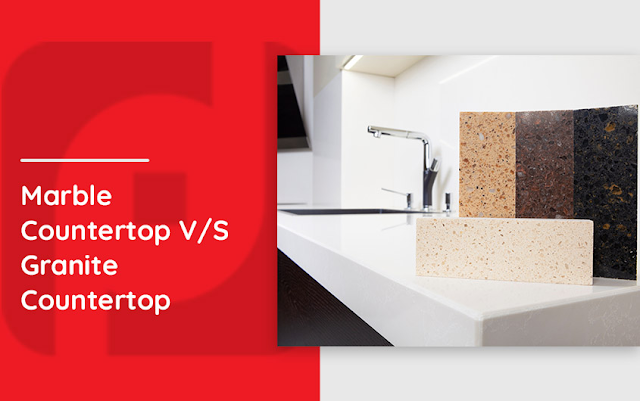Natural stone countertops in the bathroom and kitchen are an excellent choice when renovating your home. Whether you go with marble or granite is entirely up to you. There are a variety of color and texture options available with both materials. For kitchen countertops, granite and marble are two of the most popular natural stone slabs to use. Naturally occurring stone materials such as marble and travertine are popular alternatives because of the increased resale value they provide. It's not uncommon for homeowners to choose a granite countertop over a marble countertop due to its modern or traditional design aesthetics. In the end, how do you pick between two counters? It all boils down to personal taste, durability, maintenance requirements, and cost. For your next kitchen remodeling job, you may use the information in this simple guide to help you decide between granite and marble worktops.
It's not uncommon for homeowners to choose a granite countertop over a marble countertop due to its modern or traditional design aesthetics. In the end, how do you pick between two counters? It all boils down to personal taste, durability, maintenance requirements, and cost. For your next kitchen remodeling job, you may use the information in this simple guide to help you decide between granite and marble worktops.
Marble Countertop vs. Granite Countertop
1) Appearance
The distinctions in appearance between granite and marble, like those of any other material, are a matter of personal preference. Many individuals prefer the natural appearance of granite counters, which are available in various hues and patterns. Black, pink, gold, red, and green specks and veins are standard in granite countertops.
Granite is a naturally occurring stone.
Others prefer the elegance and distinct veining of marble counters, which are typically seen in black or white. Marble's pattern is more consistent than granite's because of the more prominent veins that run across the surface.
2) Durability
To ensure their long-term endurance, countertops made of marble or granite must be thoroughly sealed. Granite is a popular choice for those looking for the most durable natural countertop material because it is known for its resistance to fractures and chipping. Granite counters can usually be cut on without damaging them, hot pans can be placed directly on them, and spills can be quickly cleaned up.
Granite and marble are both extremely durable and long-lasting countertop materials. Granite, on the other hand, is far more resistant to staining. Etching can occur when acidic substances such as vinegar or lemon juice are used on marble.
3) Stain Resistant
Porousness stems from marble's metamorphic properties. Some materials will be absorbed by marble because of its porosity. To give a few examples, foods and liquids (such as tomato sauce) may stain marble, as would wine, juice, lemon, and vinegar. Granite is extremely dense, making it impervious to stains from food and drinks. When the granite is sealed correctly, even acidic substances like vinegar will not penetrate it.
· Granite
Granite worktops require less sealant maintenance than marble ones because of the granite's natural stain resistance. Depending on the type of sealer used, you should apply a fresh layer of sealant once per year or every three years for the best effects.
· Marble
Porous marble requires regular resealing to protect the surface. To prevent water from accumulating on the marble's surface, it should be resealed at least twice a year. The granite or marble surface can be tested with a small pool of water to see if a new sealer is required. If the water beads up, the current sealant is doing its job. Reapply a new sealant if water seeps into the stone.
Additional Read:
HOW TO MEASURE YOUR KITCHEN PERFECTLY
4) Maintenance
With proper maintenance and attention, these stone countertops can last for a very long time. Regular resealing of natural granite and marble is required for upkeep; however, the resealing frequency depends on the surface type and how frequently your kitchen is used.
Every two years, granite should be resealed to prevent it from becoming brittle and prone to water damage. It is possible to repair minor damage such as scratches with a color-matching epoxy, but it's best to leave significant cracks to the professionals to avoid further damage. It is recommended that granite be cleaned regularly with mild soap and water; however, abrasive cleaners should be avoided at all times. The sooner you clean up any spills, the less probable it is that they may stain, especially if they contain oil-based substances or other organic compounds. If granite is maintained correctly, it can survive for a very long time.
Marble should be resealed at least once every six months to a year. While stains can be avoided, etching is still a possibility; therefore, it is not a comprehensive solution. To thoroughly clean marble, use a pH-neutral cleaner or one that is specifically made for natural stone. Immediately wiping up any spills can assist in preventing stains and etching on your countertop, which is more porous than granite and hence more susceptible to etching. Make sure that you use a premium surface-specific detergent to remove stains from the surface. Although marble can last for an extended period, it is more susceptible to wear than granite due to the following advice.
5) Installation and Price
An expert should do the installation of both granite and marble. These items are hefty and cumbersome to move about. Aside from that, making holes for a sink and other fittings isn't a simple operation.
Granite Countertops are often less expensive than marble in terms of cost. Granite countertop prices have dropped from $175 per square foot to as low as $75 per square foot in recent years.
Marble countertops can cost anywhere from $100 to well over $200 per square foot installed, depending on the quality and design of the piece. Tiles rather than slabs will save you money on marble.
To continue reading: Click Here
